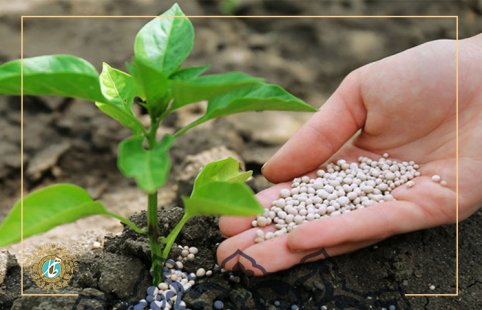
In the field of soil analysis, it should be noted that in all seasons of the year, soil sampling, which is taken from the area under the branches, should be taken at three depths of 0_40, 40_80, 80-120 cm. Appropriate fertilizer should be in accordance with the results of soil decomposition such as irrigation dose, soil texture and soil production capacity in that area.
Analysis method in the fertilization process
One of the points that should be considered in the fertilization process (pistachio tree fertilizer) is that the sample is taken from the leaf after the filling stage of the kernel, which takes place in mid-July. More leaf sampling is done for the next year's fertilizer process Which is taken from the rule of unloaded branches.
Leaf decomposition method is one of the most accurate and best methods to meet the fertilizer needs of pistachio trees.
In the process of selecting and gathering information about the appropriate fertilizer for pistachio trees, it is better to pay attention to important fertilizer points such as the following:
- Fertilization according to the results obtained from soil and leaf decomposition
- Observance of soil and leaf decomposition facilities for pistachio trees is often not considered.
Pistachio tree fertilizer and elements needed to feed pistachio trees
Applying animal manures (pistachio tree fertilizer) can both provide more nutrition to the tree and improve the soil such as building structure, plant biology, granulation and increase soil cation exchange. Types of animal manure include cow manure, sheep manure and poultry manure.
It should be noted that the amount of nutrients in poultry manure is more than sheep manure and in sheep manure is more than cow manure, but not all plant nutritional needs are met by poultry manure. Although poultry manure decomposes more rapidly than other fertilizers, it is also possible for its compounds to be lost in the soil sooner. In this case, the best thing to do is to apply sheep manure and cow manure to the soil in a dried state so that its effects are done sooner and less damage is done.
The best time to apply animal manure is from mid-autumn to early winter.
If fertilizer is not applied at this time, it can cause physiological damage such as jaundice to the leaves of trees. In addition, the plant will no longer have sufficient access to nitrogen. Especially in fertilizers that are not well rotted.
The method of using animal manure is that it should be done once every 2 years at the end of the tree that casts its shadow, so that a hole with a depth of about 50 meters is created on one side of the tree and the manure is placed inside it.
What is the application of chemical fertilizers for pistachio trees?
Another type of fertilizer used for pistachio trees is chemical fertilizers. It should be noted that to use chemical fertilizers, the amount of fertilizer should be adjusted according to the irrigation cycle. For example, any amount that increases the distance between two irrigations should be less than the amount of chemical fertilizers or nitrogen.
In the application of chemical fertilizers for pistachio trees, it should be noted that half of the nitrogen that pistachio trees need to fertilize, in March, 25% in May and the other 25% in September when harvesting with water It becomes. The amount of nitrogen fertilizer application of pistachio tree is done according to the needs of the tree in relation to the age of the tree, irrigation cycle, and fertility of the year. Phosphorus fertilizer also increases the plant's resistance to salinity and soil dehydration and has a significant effect on the amount of opening and so-called smiling pistachios.
The best animal manure for pistachio tree
As mentioned above, 3 types of animal manure (organic) including: poultry manure, cow manure and sheep manure are used to fertilize pistachio trees. Based on farmers' experiences, first cow manure, then sheep manure and finally poultry manure are suitable. Of course, how to use fertilizers depends on climatic conditions and soil conditions and water salinity.
But the best way is to use a mixture of animal manures with chemical fertilizers. So keep in mind that for best results, a combination of chemical and animal fertilizers should be used so that the soil is not degraded over time.
Leaves of pistachio trees
Sampling of the leaf usually takes place after the period of kernel development (mid-July to mid-August). This sampling is taken from the rule of unprofitable branches and is recommended for annual fertilization. The most accurate method for gardeners to determine the need for fertilizer is to use both the results of soil and leaf decomposition.
Fertilizer recommendations for pistachio trees
There are two grounds for recommending fertilizer for fertile pistachio orchards:
- Fertilizer recommendation based on soil and leaf test results
- General recommendations are not recommended due to the fact that soil and leaf decomposition facilities are available for pistachio orchards in most areas.
Spraying to increase the fruit of pistachio trees (Fruit Set)
Foliar application for fruit set (5 per thousand urea, 5 per thousand zinc sulfate and 5 per thousand boric acid)
In autumn after pistachio harvest or early spring when the buds swell or both, if the soil is salty, the boron element is removed from the formula. Zinc and barium are among the key and effective elements in the practice of pollination and inoculation in all trees. The element zinc is involved in the germination of pollen grains and helps the growth of pollen tubes and causes fertilization and fruit formation.
Zinc deficiency delays the opening of reproductive and vegetative buds in the tree.
The number of seeds per cluster also decreases, causing the clusters in the trees to become thinner.
Barium also plays an important role in pollination and fertilization. The major role of this element in flowering and in pollen and inoculation has been proven. Deficiency of this element causes the fall of flower clusters in young trees.
The element barium helps to increase the lifespan of the neck and the pistachio tree needs the element barium more than other trees. Symptoms of deficiency include twisting and spooning of leaf margins, crop hollow and sparse spikes.
Application of phosphorus, potassium and nitrogen fertilizers at the same time as the last irrigation based on soil test and annual or non-annual increases the life of the egg in the next year and also prolongs the pollination period.






User comments